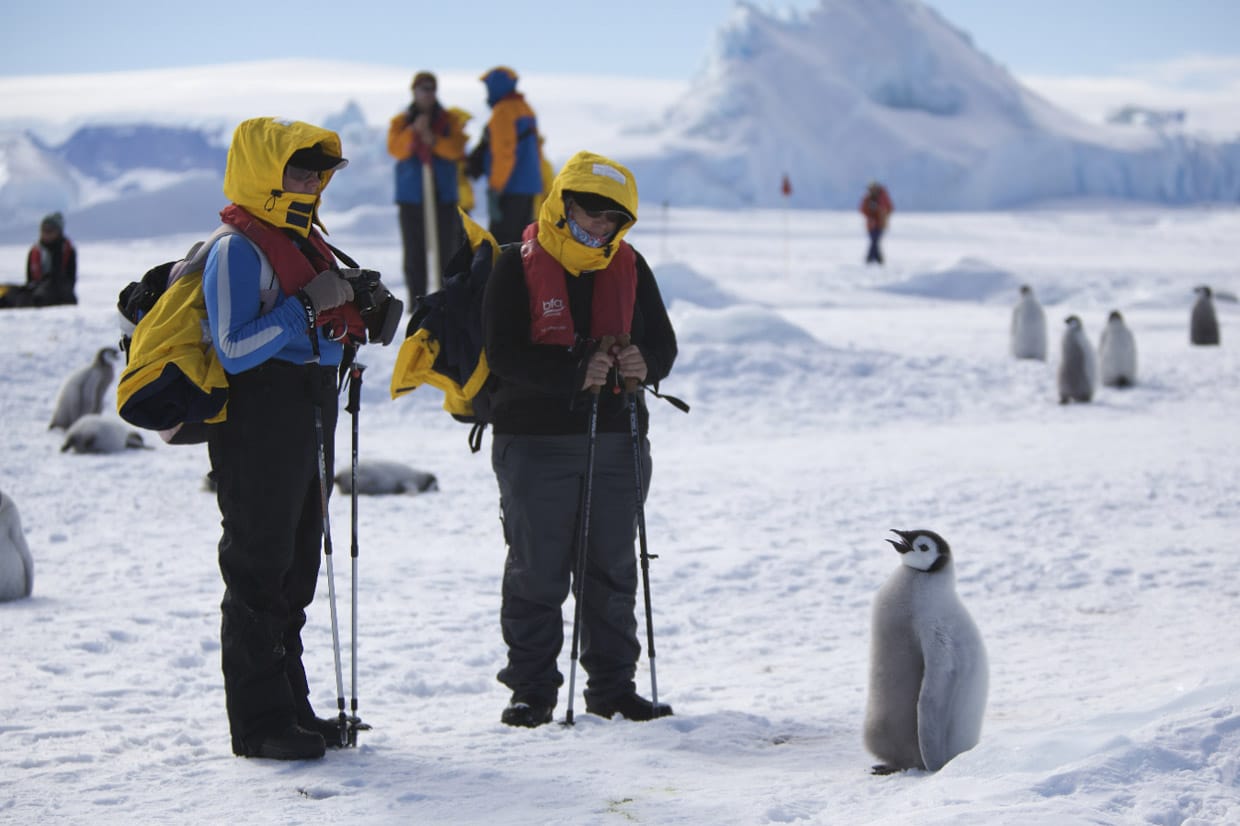
Impacts and Management
Antarctica is an incredible tourist destination of icebergs, mountains, glaciers and wildlife. Tourists are attracted by its scenery, wildlife, adventure activities and remoteness.
Warm up
Visitor numbers to Antarctica have increased rapidly with more than 37,800 tourists visiting Antarctica in 2008-09. Visits are confined to the warmer austral summer months and the majority of visits are to the Antarctic Peninsula. This increase in visitors, confined to certain areas and intensified over certain months raises questions about the sustainability and environmental impact of so many people visiting such a fragile environment.

Activity
-
What impacts are tourists having on the environment and wildlife in Antarctica?
-
Use the tourist impact sheet to fill in your answers.
Cold facts
Alien species
The photo below shows two alien species in one go! The first hoverfly (a pollinating insect) ever recorded on South Georgia in the sub – Antarctic, on a dandelion flower. Species could use the sub – Antarctic as a ‘jumping off point’ to travel to Antarctica in the future.
Tourists visit Antarctica because it is so ‘pristine‘, untouched and natural. But could seeds and spores on tourists’ clothes or small animals on tourist ships be inadvertently introduced and change this fragile ecosystem forever? Antarctica’s remoteness has prevented natural introductions of new species or introductions from humans due to the lack of human activity on the continent. Could this be under threat from invading species brought by tourists arriving from abroad? What will be the effect of climate change on the introduction of alien species?

Activity
What “alien lifeforms” could threaten Antarctica?
Read this news article from The Telegraph: “Alien Life forms are Invading Antarctica” and discuss or answer the following questions:
-
In what ways could introductions of species from abroad change Antarctica?
-
What measures can be put in place to prevent species introduction from outside Antarctica?
Learn more about the invasion of alien species in sub – Antarctica and Antarctica itself at the following websites:
Managing the impact of tourists
The overall aim is to ensure that all tourism activities in Antarctica are conducted safely, and with minimal impact on the environment. However, with increasing numbers, it is vital that the continuing growth in tourism activities is carefully planned and monitored. Under the terms of the Antarctic Act 1994, all UK visitors to the Antarctic are required to have a permit from the UK Government (FCO) or authorisation from another Contracting Party. All activities are subject to assessment of their environmental impact and applicants must ensure their visit is fully self-sufficient which includes demonstrating they have adequate contingency plans and search and rescue provisions in place.
The Antarctic Treaty nations have agreed a range of measures to regulate tourism in the region, including Visitor Site Guidelines. The guidelines help tour operators to manage tourist visits responsibly and sustainably, minimising the impact on the environment and wildlife. They also apply to the staff of Antarctic operators when on recreational visits.
Regarding Environmental Impact Assessments Article 3 (1) of the Protocol states “The protection of the Antarctic environment and dependent and associated ecosystems and the intrinsic value of Antarctica, including its wilderness and aesthetic values and its value as an area for the conduct if scientific research, in particular research essential to understanding the global environment, shall be fundamental considerations in the planning and conduct of all activities in the Antarctic Treaty area.”
Article 2 states that “activities …. shall be planned and conducted to limit adverse impacts on the Antarctic environment and dependent and associated ecosystems …”. Article 3c) goes on to say that “activities shall be planned and conducted on the basis of information sufficient to allow prior assessments of, and informed judgments about, their possible impacts on the Antarctic environment and dependent and associated ecosystems and on the value of Antarctic for the conduct of scientific research”
Article 8 deals specifically with environmental impact assessments and sets out the procedures in the planning processes leading to decisions about any activities including science, tourism and all other governmental and non-governmental activities in the AT area. It introduces the concept of “minor or transitory impacts” as a measurement and details the procedures to follow (at Annex I) depending upon whether the planned activity will have “less than a minor or transitory impact”; “a minor or transitory impact” or “more than a minor or transitory impact”. In essence, the Protocol notes the importance of science but highlights the need for prior assessment of any impacts and for mitigation – the greater the impact the greater the in-depth assessment and the need for mitigation.
The impact of tourists on penguin colonies
One of the reasons tourists go to Antarctica is to see the wildlife and penguins are always a popular attraction. For 12 years the British Antarctic Survey and the UK Antarctic Heritage Trust who operate Port Lockroy on Goudier Island, have been studying breeding performance in ten colonies of gentoo penguins, including 600 pairs in sites visited by tourists and 200 pairs of gentoos in colonies off the tourist trail.

The study at Goudier Island is a valuable long-term dataset. It is only with such long-term datasets using consistent methods that the impacts of controlled and regulated tourism can be found.
The results of the study show that at two of the six visited colonies, gentoo breeding pairs are showing a “a significant statistical decline but the declines may not simply be due to visitors”. At the moment at least, the impact is relatively small and there is no discernible impact on breeding success” However, if tourism increases significantly or is not well managed there is a massive potential to impact on wildlife which is why the monitoring studies are so important to help determine effective management measures and further research is essential looking at breeding potential well as counting the eggs that are laid and hatched.


The impact of passenger vessels
The potential of tourism to impact on the marine environment is even greater than the potential impact on the land. The sinking of the MV Explorer near the South Shetland Islands in November 2007 highlighted the potentially disastrous human and environmental impacts of Antarctic tour operations. All the passengers and crew were safely rescued but 178,000 litres of fuel and 24 tons of lube oil is probably still sitting at the bottom of the ocean and which will be gradually released into the marine environment. So far there has been no sign of pollution but the possibilities are still there.
The Antarctic Treaty Consultative Parties are working towards greater control over tour ships in the area. At the ATCM in April 2009, a Measure was passed banning ships carrying more than 500 passengers from landing in Antarctica, and restricting other landings to a maximum of 100 passengers ashore at any one time, with a minimum ratio of one guide to every 20 passengers. These procedures have been voluntarily adopted by IAATO for some years. Voluntary procedures are important because the Antarctic tourism industry continues to grow: in the 2019-2020 tourist season 74,401 visitors travelled with IAATO members to the continent with 18,506 on cruise-only vessels.
In addition, the Treaty Parties have been working with the International Maritime Organisation (IMO) to prevent ships from carrying and burning heavy fuel oil in Antarctic waters. The ban will come into force in mid-2011. This will mean that large cruise vessels, which operate on heavy fuel oil, will not be able to sail in the area unless they use alternative, more environmentally-friendly, fuels.
The Treaty Parties and IAATO have also instigated measures to improve communications and vessels regularly report their positions. In December 2009, the International Maritime Organisation adopted revised guidelines for ships operating in polar waters and is now actively working on a mandatory Polar Shipping Code which is expected to be adopted in 2012. The Code will set compulsory standards for vessels intending to operate in the high latitudes.
The UK already requires British cruise ships to demonstrate that they are not operating in isolation whilst in Antarctic waters and is continuing to encourage other Antarctic Treaty Parties to do likewise. In the past many ships have wanted to be out there alone, selling this wonderful wilderness experience, but now the industry actively encourages vessels to cooperate with one another so they are able to provide assistance in the event of an incident.
-
More information can be found on the IAATO website.
Student activity 1
What measures can be taken to reduce the environmental impacts on Antarctica?
Imagine that you work for the International Assocaition of Antarctica Tour Operators (IAATO) as their Tourism Impacts Advisor, you have been asked to develop 10 guidelines for tourists to Baily Head to be ratified at the Baltimore ATCM in 2009 to minimise environmental impacts. You have been given the following issues to consider: wildlife, vegetation, species introduction, litter, ships, adventure sports and historic buildings.
-
Download and fill in the chart to get you started.
-
Use the information in the Warm Up section to help you.
The Antarctic Treaty of 1959 governs activities on Antarctica. In 1998, a protocol called the Madrid Protocol on Environmental Protection was put in place which sets out guidelines to help protect the Antarctic environment and its ecosystems from tourist activities.
Learn more about the guidelines that have been developed at the following websites:
-
Discuss how they differ or are the same.
Student activity 2
Q&A: Minimising the impact on penguins
The British Antarctic Survey has the longest running study into the impact of tourists in Antarctica based at Port Lockroy one of the most popular destinations with more than 16,000 visitors in the 2007/08 season.
-
Suggest measures that could be taken to minimise the impact of the tourists.
-
Group sizes are restricted to 20 and landings must be staggered throughout the day.
-
Visitors also need to remain outside the natural boundary of the colony
-
Keep at least five metres from wildlife
-
Give the birds the right of way, there are ‘penguin highways’ down to the beach with the birds going out foraging, so you mustn’t block their tracks
Student activity 3
Are tourists using Antarctica sustainably?
As a journalist for a leading newspaper you have been asked to write a balanced news article or a report considering whether tourism in Antarctica is currently sustainable. You need to show both points of view.
-
Use the links and the downloadable plan to help you.
Learn more about sustainable tourism at the following websites:







